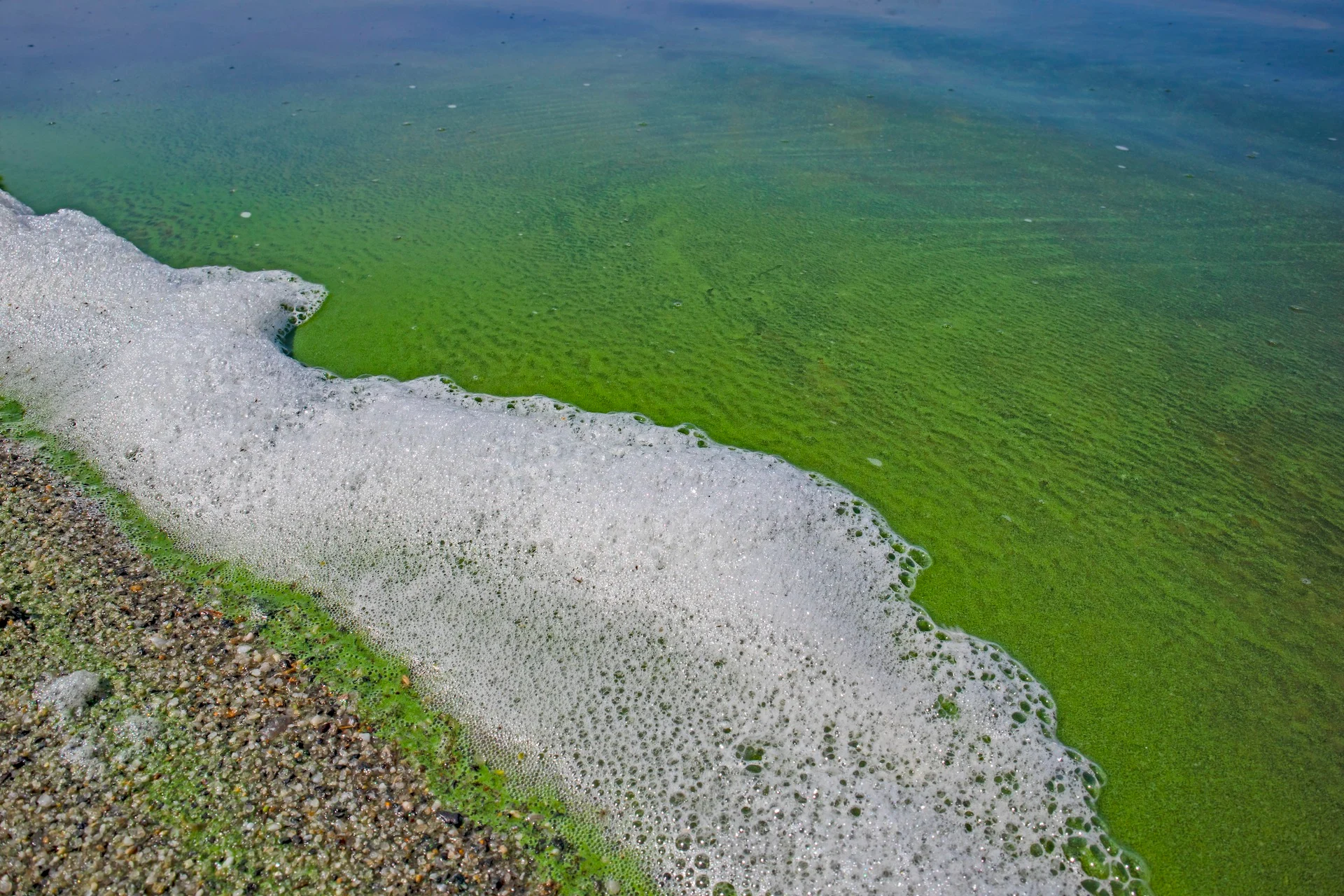
Some anglers consider algae blooms helpful — but what are the health effects?
Despite often being described as smelly and not nice to look at, Eric Hirzel and Matthew Hehn say they find algae blooms helpful when it comes to catching more fish in Lake Erie.
Both are longtime charter fishing captains who patrol the lake's western basin, primarily pulling walleye (pickerel) and yellow perch from the water.
SEE ALSO: Blue-green algae can be tricky to spot, how to recognize it
Algae blooms are caused when algae grow quickly in water systems from excess nutrient run-off, like phosphorus or nitrogen from fertilizer.
One of the largest recently recorded algal blooms in western Lake Erie occurred in 2017.
Hirzel, from Ohio, said if the blooms get thick enough, they provide enough shade that fish often accumulate underneath the green slime, making it easier to hook them.
"Sometimes, it's not like we're running away from these blooms," said Hirzel.

Eric Hirzel, left, and Matthew Hehn are fishing charter captains in western Lake Erie. (Eric Hirzel/Matthew Hehn)
"A lot of times, we're going right to them. It's not very pleasant to look at. It's sometimes not very pleasant to smell it, but the fish are certainly active under it."
Hehn, from Michigan, agrees, calling it "kind of a running joke" in the charter industry and specifically the group he fishes with.
"It's almost like the walleye have sunglasses at that time of year and then a flat day with the algae bloom … the bites continue to be very good still, where if we don't have that algae bloom and it flattens out, and it's really high sun, the bite will typically slow down quite a bit."
Can humans get sick from eating fish exposed to algae blooms?
Hehn said that from his experience, fish typically aren't eating algae on the surface.
"Everything I've ever heard from the Michigan DNR [Department of Natural Resources] and then through the Great Lakes Fisheries Commission is that algae doesn't have any effect on the quality of the meat or anything like that."
But what do the scientists say?
The director at Ohio Sea Grant and Ohio State University's Stone Laboratory said fish can accumulate toxins from algae blooms in their flesh.

(Cristine Isenor/Submitted)
However, according to Chris Winslow, academic and agency research isn't showing high enough fillet concentration levels to justify additional warnings, in fear of transferring toxins to people who eat them.
"There is already a fish consumption advisory in place for Lake Erie fish and it's primarily based on mercury," said Winslow.
"But what we're finding is the toxins in the fish tissue are not trumping the mercury consumption advisory, so long as you're following the advisory that's been in place since the 70s … those toxins have not made it any worse."
Are fish impacted by exposure to Lake Erie algae blooms?
René Shahmohamadloo has published a research paper on how Lake Erie fish are safe to eat despite being afflicted by algal hepatotoxins, but he's also concerned about the health of the fish.
The ecotoxicologist and postdoctoral scientist said he hopes his work can advocate for a "voiceless" fish population.
"What about the fish themselves who have no choice but to swim in these potentially very toxic baths?" said Shahmohamadloo, who's dually affiliated with Washington State University and the University of Guelph in Ontario.
"I find it fascinating how we can look at this story because it shows how human centric we've become … if it's not an issue to us as a human species, let's keep life going on."

(Getty Images-1083371312)
After two rounds of sampling, Shahmohamadloo said their study suggests the levels of concentrations would be of concern to fish population growth and development.
Some fish were harbouring unhealthy levels of microcystins — a liver toxin — before, during and after major algae bloom events, he said.
"It's suggestive that it could be an issue for their own growth, development and population dynamics."
Shahmohamadloo said there's a chance fish are flocking together underneath the blooms because they're stressed out.
"It's easy for us to fish them, but there could potentially be a serious biological reason that's causing the fish to congregate that way, like cyanobacteria. We need to be careful when we think about these blooms."
In contrast, Winslow said, he needs to see more "definitive" research to support the idea that fish are being affected by the toxins.
"We don't seem to see that it's killing fish and we don't even seem to think that it's affecting their behaviour or their growth to date."

René Shahmohamadloo, an ecotoxicologist and postdoctoral scientist, is shown holding a flask of cyanobacteria. (René Shahmohamadloo)
How have blooms been so far this summer on Lake Erie?
The National Oceanic and Atmospheric Administration (NOAA) continues to predict a low to moderate-sized bloom across the western Lake Erie watershed this summer.
On a scale of 1 to 10, the U.S. federal agency expects a severity level range of 2 to 4.5 because of a dry spring and low phosphorus loads into the lake.
As of July 24, the current bloom in western Lake Erie has an approximate area of 620 square kilometres, with scum likely showing up nearshore around parts of Michigan and Ohio.

Satellite imagery showing cyanobacterial density levels across Lake Erie. (National Oceanic and Atmospheric Administration)
Rajesh Bejankiwar said even though they don't change the severity of algae blooms, wind and wave action can impact them across the western basin of Lake Erie.
The International Joint Commission scientist said they can alter how blooms spread, and collect at beaches and local shorelines.
"If you have a big amount of algae and if there is a wind from south to north, obviously the blooms will move towards the north shore of Lake Erie and then we'll see more on our shoreline, on the Ontario side," Bejankiwar said.
Sandy Bihn lives at the mouth of the Maumee River and Lake Erie — an area widely viewed as a main source of phosphorus load into the lake from livestock manure.
She's also the executive director for an advocacy group called Lake Erie Waterkeeper — with a focus on algal blooms.

Lake Erie is shown from Pelee Island in the summer of 2023. (Cathy Miller)
Bihn said she expects the bloom to be bigger in August and September because of the recent rainfall we've seen.
"These blooms are caused by usually six to eight major events in a year," Bihn said.
"The waters are a little cooler this year. Water levels are down this year from what they've been a little bit. How much that factors in temperature certainly does play a role in it, but I suspect we're going to have a large bloom in August and September."
The health of Lake Erie is "immeasurably important" to Pelee Island, according to its mayor.
So far, Cathy Miller said there's nothing notable to report along Canada's southernmost shoreline.
"Our main industries of agriculture and tourism are both reliant on a healthy lake — as is most of mainland Ontario," said Miller.
"Tourism has been negatively impacted in years where massive blooms have impacted water quality."

Pelee Island Mayor Cathy Miller says, 'Tourism has been negatively impacted in years where massive blooms have impacted water quality.' (Cathy Miller)
She said the island consistently tracks algae bloom reports from a handful of agencies, adding despite algal blooms affecting small communities like Pelee Island first, that it's an "international issue that ultimately could affect us all."
"It is my perception that Ontario's 12-point plan to address this issue has been effective."
Everyone who draws on Lake Erie for drinking water could be impacted by high levels of algae and algal blooms, added Miller.
"Residents draw from personal wells, small drinking water systems, sand points and the municipal water system. The municipal water system is heavily monitored and regulated to ensure safety."
WATCH: Essential Arctic algae found littered with microplastics
Thumbnail courtesy of Getty Images-1168956953.
The story was originally written by Bob Becken and published for CBC News.









